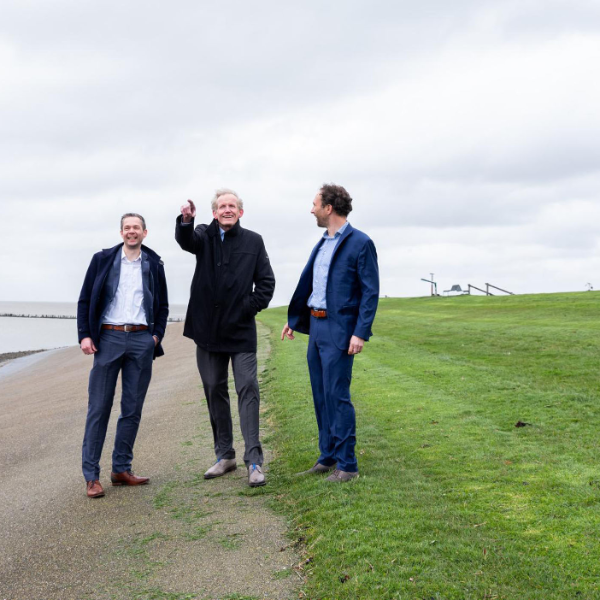Koehool-Lauwersmeer dyke improvement

Koehool-Lauwersmeer dyke improvement
Textbook example of sustainable collaboration
The Koehool-Lauwersmeer dyke improvement project stands out due to its unprecedented scope: almost 50 km of dyke reinforcement. Also, the project takes place in an area where major interests are at stake, particularly the Wadden Sea – a World Heritage site and Natura 2000 area – and the fertile agricultural lands that are of major significance for food production. These characteristics mean the dyke improvement project is complex and the exploration phase could take an unpredictable course. This dynamic imposed high demands on the method of collaboration between the water authority (Wetterskip Fryslân) and engineering firm.
Whereas for many years the normal approach had been to tender such projects at a fixed price, Wetterskip Fryslân chose – in view of the high demands required by the collaboration – to adopt a different approach. Aside from the quality criteria, fixed price contracts also have a considerable price incentive. Wetterskip Fryslân took a bold step in electing to obtain advisory services for the Koehool-Lauwersmeer project – their largest consulting project ever – purely on the basis of quality with a framework contract. The evaluation criteria focused on organisation, collaboration and project management. Consulting services consisted of integrated support for the Wetterskip Fryslân project team during the exploration phase of the project, which forms part of the national High Water Protection Programme.
Jan Hateboer, Wetterskip’s project manager: ‘It was a bold step on the part of Wetterskip to go with a framework contract like this. We also could’ve contracted a consulting firm on the basis of an initially smaller and more stable scope, with greater competition on price. But we knew that the scope would undergo many changes, meaning a genuine chance of contract disputes – at the expense of quality and collaboration. For Wetterskip, this really is an unusually large project, and we therefore had to approach it very differently as an organisation. Witteveen+Bos supported us in this as a fully-fledged partner.’
Hans Helder, Witteveen+Bos project manager: ‘When Wetterskip Fryslân put the tender out in this form, it immediately drew my attention. I saw it as an incredibly powerful signal that Wetterskip was willing to express so much confidence in its future contractor in this way. It also triggered something in me. I felt a strong drive to respond to this expression of trust and to transform it into a real contractor/client success story. In practical terms, this meant being a truly reliable contractor, assuming responsibility for delivering high quality work, receiving reasonable compensation for doing so, and jointly completing the exploration phase within the client’s available budget.’
'We view the Koehool-Lauwersmeer project as a great example of how mutual trust and excellent collaboration are the key to success'
Ben Strating is working on Koehool-Lauwersmeer from Witteveen+Bos’s Heerenveen office as supervisor of project management. He praises the project as a textbook example of how a consulting firm can maximally support a client: ‘It’s an enormous task. In the course of the project, its scope underwent a major revision. While the start and end points remained the same, the challenge of the reinforcement proved to be much larger and to apply to many more stretches of dyke. Also, due to various developments and regional processes within the wider coastal zone, Wetterskip decided along the way to combine the dyke improvements into a programme and tackle all developments as a single whole where possible. This increased the level of complexity, but we were consistently able to respond to this in a flexible manner. From the very beginning, we’ve used a permanent team of top experts on this project, the composition of which has remained virtually unchanged. This enables us to effectively respond to the project’s organisational dynamics.’
After the contract was awarded to Witteveen+Bos for consulting services on Koehool-Lauwersmeer, finer contractual details and financial frameworks were agreed upon. The team worked on the basis of sub-contracts, whereby scope and price were determined jointly. Ben Strating: ‘We showed even more flexibility than we would in our normal projects, and there were no client-contractor conflicts and no contract disputes throughout the entire project. We worked transparently, with a high level of mutual trust, and that made the work very pleasant and resulted in high quality.’
Jan Hateboer adds: ‘Quality improved because there was no fuss about money afterwards. Also, the contracts didn’t contain any negative incentives that could lead to inferior solutions. We made a joint prognosis that we then aimed to achieve, and we also looked for opportunities to work cost-efficiently and to avoid non-essential activities.’
In actual practice, this form of contract meant that Witteveen+Bos was able to flexibly respond to the project’s needs, and also that it took responsibility for overall expenditures. There was mutual transparency in terms of risk, budget and expenditure. Both Wetterskip and Witteveen+Bos made office space available for joint working days, allowing both parties to look behind the scenes at the other organisation. Regular performance evaluations were conducted, which were discussed together and used to determine the ‘lessons learned’. Hans: ‘That produced impressive figures. We view the Koehool-Lauwersmeer project as a real example of how mutual trust and excellent collaboration are the key to success. The fact that we’ve now been requested to extend our services into the plan development phase feels like a great reward and an expression of mutual commitment.’
More information
